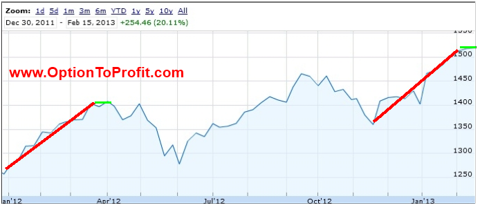 I often say that I neither believe nor follow fundamental nor technical analyses.
I often say that I neither believe nor follow fundamental nor technical analyses.
Maybe that’s because I’m incapable of understanding or learning the nuances of either. However, despite saying such, like so many things in life, the truth usually lies somewhere in-between.
I do look at charts, although I’m not entirely convinced that I know what I’m looking for or looking at when I stare at the graphic representation of what we observe in the market. On some primitive level I must be doing some kind of technical analysis because I do look for patterns, such as that mentioned about 9 months ago in how Apple (AAPL) was resembling the Google (GOOG) of 2008.
As someone who has been consistently selling options for more than 5 years, I can look at specific periods of time when those who criticize that technique would have been able to revel in their tremendous insight and understanding of price movements, while I would have been wallowing in introspection.
Luckily, that introspection never seems to last for very long.
One such period was from January 1, 2012 to mid-March 2012. One real characterization of that period, besides the seemingly higher close each and every day was the manner in which it happened. Coming immediately after the close of trading in 2011, a year in which triple digit moves in either direction were the norm, that initial period in 2012 was quite different. Those moves were rare. Instead, it was the same slow melt-up that we’ve witnessed thus far in 2013.
I’ll add the first 6 weeks of 2013 as a period that I haven’t been fully enamored of having sold options, although to be fully analytical, I’d have to admit that stock selection plays a role, as well. On paper, the adverse impact of Petrobras (PBR) and Cliffs Natural Resources (CLF), have to be given their due credit.
But looking back to 2012, it all just suddenly changed and made me feel much better about the strategy of selling options. It all started with those triple digit moves. Just as quickly, introspection gave way to a sense of high self-esteem.
As 2013 has been thus far following the same pattern, I’m beginning to see the light at the end of the tunnel.
 Again, I’ll certainly admit to a very simplistic use of charts, but just as the charts of Apple and Google at different periods in their corporate lives looked remarkably similar and portended a future path for Apple, I am struck by the similarity in the slopes of the S&P 500 (SPY) for the two periods mentioned earlier.
Again, I’ll certainly admit to a very simplistic use of charts, but just as the charts of Apple and Google at different periods in their corporate lives looked remarkably similar and portended a future path for Apple, I am struck by the similarity in the slopes of the S&P 500 (SPY) for the two periods mentioned earlier.
Qualitatively, I could tell anyone how similar those periods were, without looking at any chart, owing to my trading results. However, the parallel slopes tell a more compelling and quantitative story. Beyond that, the time periods are identical. In the case of 2012, the ascendant period was followed by a brief two week flat period, which was followed by a quick 2% market drop. That drop was just as quickly erased, restoring investor confidence long enough to go through a 1 month and 8% decline.
On this President’s Day, coincidentally we are just concluding a two week period of calm and flat performance, with the S&P 500 having moved 2 points in that period.
There’s certainly no rule that I know of that insists that events repeat themselves. In this case, looking back at my 2012 results, I certainly hope that they do, as it is always preferable for the covered option seller to be doing so in a flat or down market.
Of course, a rational mind will ask what the stimulus might be for a market reversal or any large move regardless of direction. Whereas individual stocks may not require a publicly known stimulus to have a large and sudden move, the market itself needs some overt catalyst. Back in 2012, perhaps it was news of a double dip in the Spanish economy or Greek elections that turned out austerity. Who really knows?
On the horizon, the only known entity is the “sequester.” However, it’s really anyone’s guess where its current deadline for resolution may take us. The recent “Fiscal Cliff” was rationalized by many as being the impetus for the gains of 2013, but it’s not clear to me what effect the sequester may have, regardless of political agreement, or not. Any reduction in spending would be a positive and I believe that the market, which is still rumored to discount events six months into the future, is expecting some kind of resolution.
With less than two weeks to go for the clock to stop ticking, it’s hard to imagine the market being propelled forward on any agreement. Of course, it’s certainly easy to see how another delay or “kick of the can down the road” could be unsettling, especially to credit markets. Standard and Poors may have their own headaches right now with issuance of past credit ratings, but they still do have a job to do.
While politicians may avoid the risk of being labeled “unpatriotic” for voting in favor of defense cuts, they free themselves of that charge if no agreement is reached by March 1,2013, which is just in time for a repeat of 2012.
If I were very concrete and believed that we must stick not only to the same pattern but to the same time frame, I would paint a scenario that envisions a quick 2 week sell off while some gloom sets in regarding agreement on the sequester. That, of course, would have to be followed by another 2 week period, but this time rebounding as it appears that positive movement is occurring.
That brings us to the deadline and the charting anniversary for a large market drop as either there is agreement or there is no agreement.
Win-win, especially if you’re a covered option selling politician.
